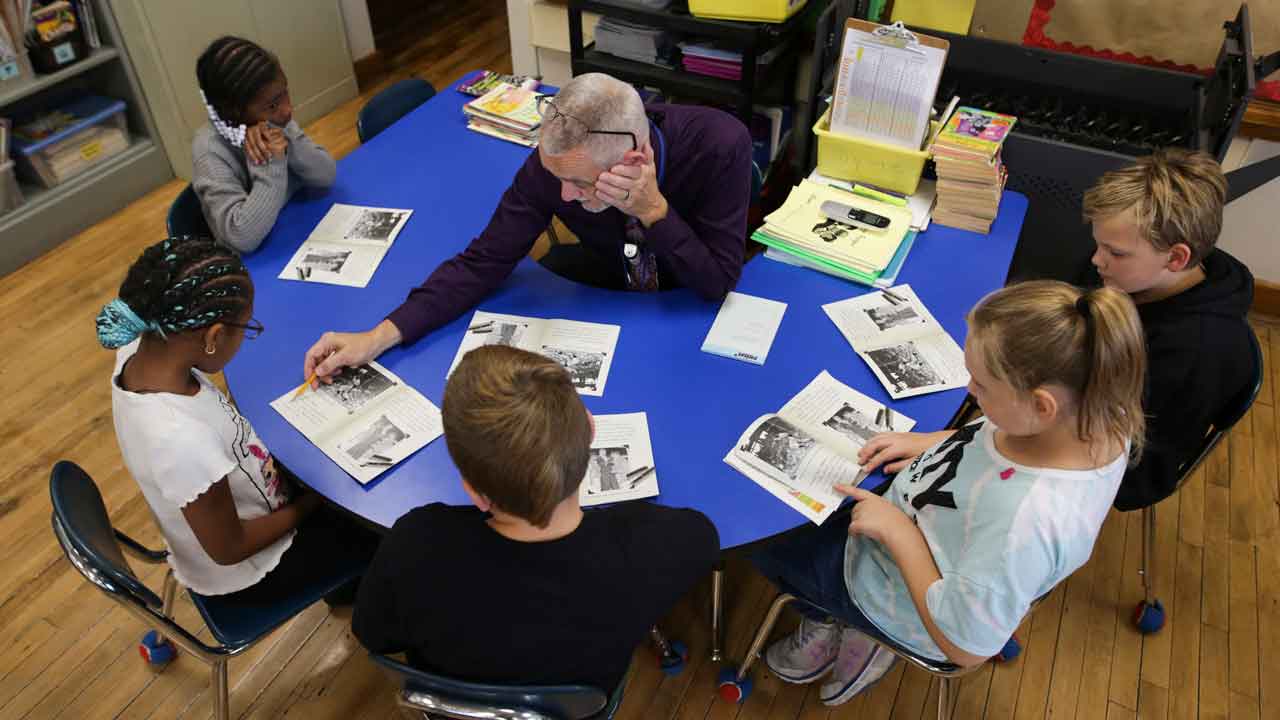Global Courant 2023-05-22 17:58:18
Richard Evans makes his way through the rows of students in his third-grade classroom, bending down to pick up a stray pencil and answering questions over the noise of sliding chairs on hardwood floors.
The desks, once spread apart to fight COVID-19, are back together. Masks cover only a few faces. But the pandemic remains undeniably present.
Look no further than the blue horseshoe-shaped table at the back of the room where Evans calls a handful of students back at the end of each day for extra help with reading – a crucial subject for third grade.
This is where the time lost to pandemic closures and quarantines comes into play: in the students repeating this grade. Words sounded one syllable at a time in the little fingers that slowly slid under them. In the teacher’s patient coaching through reading concepts usually mastered in first grade – letter ‘blends’ such as ‘ch’ and ‘sh’.
It is also here that Evans notes pluses and minuses and numbers on charts he has created to track each child’s comprehension and fluency, circling and underlining words that trip a student a second or third time.
In a year when the stakes are high to make up for missed learning, this strategy — assessing individual students’ knowledge and tailoring instruction to them — is one of the most widely adopted in U.S. elementary schools. In his class of 24 students, each impacted in a different way by the pandemic, Evans faces the pressing challenge of getting them all to read well enough to succeed in the upcoming grades.
Here’s how he handled it.
US SCHOOLS REPEAT TO CATCH UP READING AFTER COVID ACADEMIC PROGRESS SILENCE
Going from pandemic to ‘NORMAL’ is hard
It’s a Thursday in October, early in the school year. Six students surround Evans at the blue table, each staring at a first-rate book on baseball great Willie Mays. Many are struggling.
“What sound does ‘-er’ make?” Evans asks 9-year-old Ke’Arrah Jessie, who focuses on the page through a pair of glasses. She puts “hit” and “ter” together to make “hitter.”
Next to her, a boy takes a turn. He pronounces ‘high’ as ’hig’. Evans picks up a pen and jots down “night” and other “igh” words for a sidebar phonics refresher on letter grouping. Meanwhile, the rest of the class reads independently. While some browse lower level readers, others delve into advanced chapter books.
Most of these students were sent home as preschoolers in March 2020. Many spent the entire first grade full-time or part-time distance learning from home. Even after schools reopened full-time for second grade, COVID-related obstacles persisted: masking and social distancing rules that prevented group work, quarantine that sent children home without warning for a week, and young children who by then were not used to – and not satisfied with – full weeks of school rules.
Says Evans, who started teaching at age 40 after a career as a computer graphic designer: “All year round, kids would ask me, ‘Why do I have to be in school for five days?'”
From ‘learning to read’ to ‘reading to learn’
At the start of this school year, evaluations showed that 15 of Evans’ first 23 students were reading below grade level. Of those, nine were considered severely deprived as they lacked basic basic skills usually taught in first grade. In a normal year, four or five students read at the lowest level, he said.
“I know I have to do something about that. That’s my job,’ Evans said, looking back.
There’s no time to lose. Third grade students are under a lot of pressure to move from “learning to read” to “reading to learn.” Studies show that those who cannot read fluently at the end of this school year are more likely to drop out or not finish high school on time.
Among those who started at the back is Ke’Arrah, who spent more than a year learning remotely early in the pandemic. Her mother, Ashley Martin, saw the toll on her daughter’s eagerness to learn. So when Ke’Arrah was sent to a new elementary school this year, her mom re-enrolled her in third grade.
A Hyde Park Elementary School teacher helps a student pronounce a word during a classroom reading circle on October 20, 2022 in Niagara Falls, New York. (AP Photo/Joshua Bessex)
The pandemic ended first grade for Ke’Arrah. To keep the family safe, Martin also kept Ke’Arrah home in second grade, even if she had the option to return to school in person two days a week. She has four children younger than Ke’Arrah, including a son who was born just three days before COVID-19 closed schools and businesses in March 2020.
“It was good for me, but not great for her because she’s in front of a computer,” says Martin, whose employer, a restaurant, has temporarily closed.
Ke’Arrah, who loves math and wants to be a police officer, remembers the attraction of her neighborhood toys as she tried to stay focused on her on-screen teacher.
“She was talking about boring things,” says Ke’Arrah. Last year’s transition to brick-and-mortar school was difficult, her mother said. She finished behind in math and was reluctant to read.
Halfway through her second stint in third grade, Ke’Arrah is showing progress. Martin passed on her love of the Junie B. Jones series of books to Ke’Arrah, and the pair read them together before bed. Small moments also become reading lessons.
“She’s on the phone, I’m like, ‘Read that to me. Tell me, what does that say?’ We’re somewhere: “Read this. What does it say?”, says Martin.
MORE SCHOOLS IN THE UNITED STATES EMBRACE FONICS LESSONS ON TRADITIONAL ‘WHOLE LANGUAGE’ EDUCATION
Doubling of children who need it most
While many students are behind, Evans also referred more applicants than ever — five — to the school’s honors program because of their advanced scores in early assessments.
He took aside students who were reading well above elementary school level at the beginning of the year and explained that they might not get as much one-on-one time with him, something he had never done before. That has enabled him to double the time he was able to spend helping other students catch up by working with some groups two or three times a week. The advanced readers spend that time reading and collaborating.
The range highlights the diverse experiences during the pandemic, with some having more support at home than others.
“Were they read to? Was someone there to support them with assignments and homework when they were not physically with the certified teacher and receiving direct instruction?” says Marcia Capone, assessment administrator in the district, which provided devices and internet hotspots to families.
In Niagara Falls, about one in four people live in poverty, and 80% of the district’s students are economically disadvantaged, state data shows. Despite flocks of tourists to its namesake falls, the town of Rust Belt has been marked by an exodus of heavy industry and population that began in the 1960s.
Districts like Atlanta have tried to address learning losses by adding time to the school day. Others, such as Washington, DC, have pursued “high-impact” tutoring. Niagara Falls City Schools have redoubled their efforts in remediation and differentiated learning, adapting student lessons to advance each student. The district has used federal pandemic relief money to put 12 reading specialists to work with first graders in its eight elementary schools, Superintendent Mark Laurrie said.
Using assessments to identify students’ individual needs is the main strategy U.S. schools are using to help kids catch up to the pandemic, closely followed by corrective instruction, according to a federal study.
It worked with this student – for a while
Evans invested his own time in one of his most needy students, a boy who is repeating third grade at Evans’ insistence. He started holding it once a week after school for an hour of intensive reading intervention.
“He’s like my little experiment,” Evans said after a tutoring session in November. “Can you turn this around with intensive intervention?”
The two had just slowly worked through a phonics worksheet where students had circled words that began with the same letter as pictures. In one issue, “candy,” “open,” and “after” followed a picture of an ant. “Open?” guessed the fidgeting student.
Evans made him close his eyes and say the words, thinking about the first sound of each. The trick eventually led him to the correct word, “na.”
In other lessons, the student struggled to identify rhymes and consonants. Each problem revealed a different concept that had not yet been mastered.
“Very good!” Evans said after the boy correctly added the missing “rd” to the end of lizard. He replied with a satisfied smile.
In a matter of weeks, the boy knew just 11 sight words — common words like “because” and “about” that students should recognize immediately — to 66 out of 75 on the district’s third grade list.
“I want to be able to read chapter books, and I want to read great old dictionaries!” said the boy after a one-on-one tutoring session in which he worked on the sounds letters make when they are together, such as “sp” and “sn.”
Then, halfway through the school year, the child stopped attending school. Evans said his student lost interest; without a parent’s nudge, there’s only so much he can do.
Earlier in the year, the child’s mother had described pandemic remote learning as fraught. The family had internet connection problems and it was difficult to schedule school sessions around her work as a nursing home assistant.
“I have a younger daughter at home and it was just a mess. She screams. It was just a whole thing,” she said on the phone.
When the tutoring ended, she did not respond to follow-up calls or texts.
CLICK HERE TO GET THE FOX NEWS APP
Show students ‘There is a concern for you’
Midway through the school year, a new set of assessments suggests that Evans’ strategy is generally working. He loads the results into an Excel spreadsheet that, combined with his own running charts, allows him to evaluate growth from September to January and regroup students based on where they need help most.
“Thank goodness for paper and sticky notes,” says Evans.
What he saw in the cards before him was encouraging. Fifteen of his students had met or exceeded their scoring goals for this round of testing. Several people who receive targeted help made the greatest gains.
Ke’Arrah jumped from a lower floor to the top floor – much to the relief of her mother, whose decision to let her daughter repeat third grade seems to have paid off.
“I know it’s going to be embarrassing when she gets older, ‘Oh, you’re a grade behind,'” Martin said. “But she will have that knowledge.”
Despite the progress of the students, even some who see a big leap forward in the final assessments in May could end up behind typical third graders. Evans has arranged extra shifts for next year for three of his most needy students, including the boy he tutored after hours. But they’ll be far enough along to move on to fourth grade.
For the first time in his seven years of teaching third grade, everyone was moving forward, says Evans. “I don’t know if it’s the programs we use or if everyone is investing more in them now.”
Perhaps, he said, everyone in the building invested more in catching up with them by having so many students behind them — “making them aware, ‘You know what? There’s a concern for you.'”








